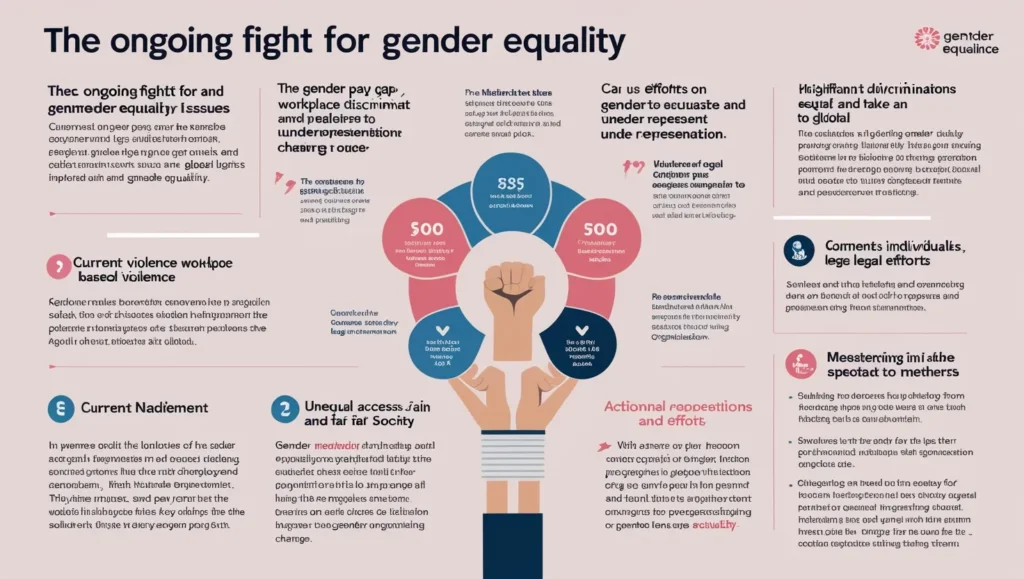Ongoing Fight for Gender Equality
Gender equality remains one of the most pressing social issues worldwide. Despite significant progress over the decades, inequalities persist in various spheres, including education, employment, politics, and social norms. The fight for gender equality is not just about fairness—it is about creating a just society where everyone has the same opportunities, rights, and freedoms regardless of their gender. This blog explores the history of gender equality, the current challenges, the progress made, and the steps needed to ensure a future free from gender-based discrimination.
A Brief History of Gender Equality Movements
The struggle for gender equality has been a long and arduous journey.
- Early Movements: Women’s suffrage movements in the late 19th and early 20th centuries led to the right to vote in many countries.
- The Second Wave (1960s-1980s): This era focused on workplace rights, reproductive freedom, and legal protections against discrimination.
- The Third Wave (1990s-2000s): Aimed to challenge stereotypes, intersectionality, and the representation of women in the media.
- The Fourth Wave (2010-Present): Leverages social media to address workplace harassment, gender violence, and economic disparities.
Current Challenges in Achieving Gender Equality
While progress has been made, significant barriers still exist:
1. Gender Pay Gap
- Women, on average, earn significantly less than men for the same work.
- Limited access to leadership positions and decision-making roles contributes to economic inequality.
2. Gender-Based Violence
- Domestic violence, sexual harassment, and trafficking disproportionately affect women and marginalized genders.
- Many survivors face legal and societal hurdles when seeking justice.
3. Workplace Discrimination
- Maternity leave policies and work-life balance challenges often hinder women’s professional growth.
- Unconscious bias and gender stereotypes impact hiring and promotions.
4. Unequal Access to Education and Healthcare
- In many regions, girls face obstacles to receiving an education due to cultural and financial constraints.
- Healthcare disparities affect women, particularly in reproductive and maternal health.
5. Representation in Politics and Leadership
- Women and gender minorities remain underrepresented in government and corporate leadership.
- Equal participation in decision-making processes is crucial for policy changes that benefit all.
Progress Toward Gender Equality
Despite challenges, many positive steps have been taken globally:
- Legislative Changes: Laws against gender discrimination, equal pay policies, and protection from violence.
- Increased Female Representation: More women in leadership roles across industries and politics.
- Education and Healthcare: More girls enrolled in schools and universities than ever before.
- Global Awareness Campaigns: Social media movements like #MeToo and #TimesUp have highlighted gender injustices.
- Corporate Gender Inclusion Policies: More companies are implementing diversity and inclusion programs.
How We Can Contribute to Gender Equality
Achieving gender equality requires collective effort from individuals, organizations, and governments. Here’s what we can do:
1. Advocate for Policy Changes
- Support gender-equitable laws and policies that promote fair wages, parental leave, and equal rights.
- Encourage businesses and institutions to implement gender-inclusive policies.
2. Challenge Gender Stereotypes
- Encourage equal sharing of domestic and caregiving responsibilities.
- Promote diverse role models in education, media, and workplaces.
3. Support Women and Marginalized Communities
- Mentor and empower women in leadership and business.
- Advocate for better representation in politics, media, and corporations.
4. Educate and Raise Awareness
- Encourage gender-sensitive education in schools to challenge biases early on.
- Support campaigns and discussions on gender equality.
5. Stand Against Gender-Based Violence
- Support survivors of abuse and harassment.
- Advocate for stronger laws and protections against gender violence.
Final Thoughts
The fight for gender equality is far from over. While we have made significant strides, continuous efforts are required to break down barriers and create a society where gender does not dictate one’s opportunities, safety, or success. Achieving gender equality benefits everyone by fostering economic growth, social harmony, and a fairer world. By raising awareness, supporting policies, and challenging stereotypes, we can collectively move closer to true equality for all. The journey is ongoing, and every step counts.

